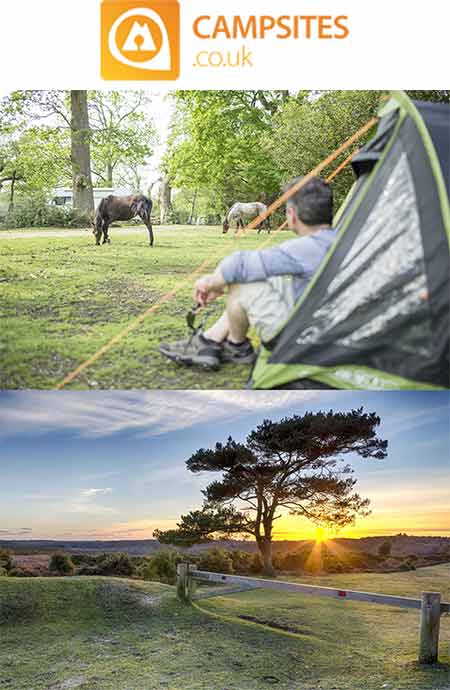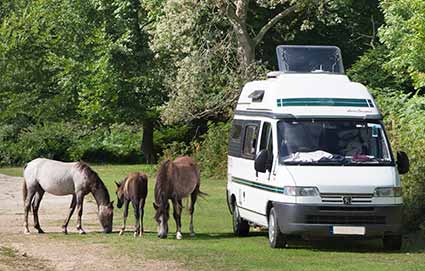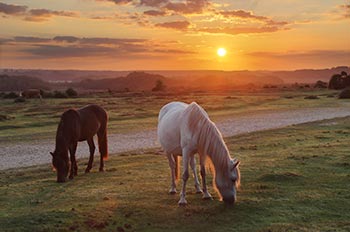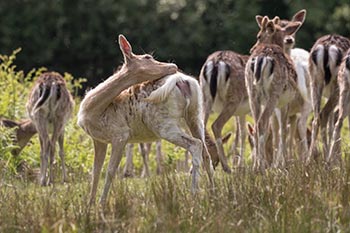New Forest Camping | New Forest Caravanning - an introduction

New Forest camping and caravanning offer great value for money. A good quality tent, equipment and accessories, for example, can be bought for less than the cost of a family holiday abroad in a hotel, and once the initial outlay has been made, the gear can be re-used year-after-year for full-scale holidays and weekend breaks.
Caravanning, of course, requires a little more expenditure, but otherwise, the same principles apply. And there is always the option of hiring a holiday caravan sited on an established caravan park.
New Forest campsites and caravan sites are located throughout the area. Those on the Crown Lands – the open lands of the New Forest - are managed by 'Camping in the Forest', whilst there is also a choice of privately owned, independent New Forest campsites and caravan parks, including those with holiday caravans for hire. Visitors should note, though, that pitching tents in places away from the organised campsites is not allowed.
New Forest campsite and caravan park facilities vary widely, and range from little more than a field or plot of land, right the way up to well-equipped holiday parks with bar, swimming pool and shop. Charges are equally variable, and usually reflect both the facilities available and the time of year - Bank Holidays and high summer usually attract the highest charges.
Of the sites operated by 'Camping in the Forest', Setthorns is open throughout the year, whilst almost all the others are open from March or April to the end of September. Holmsley, though, remains open until the beginning of November; whilst Aldridge Hill does not open until the end of May and closes at the beginning of September, with often a close-down period in-between these dates.
Similarly, a small number of privately owned sites are open all year round, but many are open only in spring, summer and into the autumn.

But whatever the season, New Forest camping and caravanning have much to offer. They are attractive for those who simply want to relax in beautiful surroundings, yet appreciate the convenience of nearby towns and villages. Families with children, who want space for play and exploration, also find much to their liking, and so do those who simply want a holiday at relatively low cost.
Walkers, too, are well-catered for, with many miles of New Forest tracks and paths quite literally on the doorstep, whilst there are few better ways of getting close to nature. Grey squirrels, for example, are often widespread around the campsites, whilst deer, foxes and badgers often wander through after dark, when all is quiet.
Birds, though, perhaps provide the greatest interest, so-much-so that many regular users of the campsites bring with them feeders to erect beside tent or caravan. Then, it’s not unusual to see great spotted woodpeckers, nuthatches, marsh tits and many other species attracted to the feast.
Commoners’ ponies, too, are often regular visitors to the 'Camping in the Forest' sites, and whilst some might find the prospect a little daunting, the stock are an integral part of the landscape and add memorably to the overall New Forest camping experience.
Find out more about camping and caravanning in the New Forest:
Quick linksSearch this site
Sika deer continue to engage in rutting behaviour, and will do so until December.
Pigs seek out the remains of the acorn crop.
Beech leaves are transformed into a magnificent mosaic of glorious reds and golds. Other deciduous trees, too, take on an autumnal cloak before their leaves fall.
Dragonflies can occasionally be seen on the wing on bright days early in the month.
December
Foxglove leaves survive the winter at ground level, and offer the prospect of colourful summer blooms to come.
Redwings and fieldfares, autumn and winter visitors, gorge on haws and holly berries.
Great grey shrikes and hen harriers hunt over the heaths and other open spaces.
Honeysuckle by the end of the month often shows welcome signs of new growth.

Sadly, 58 animals were killed - 35 ponies, 13 cows, 8 donkeys and 2 sheep, whilst a further 32 were injured - 3 pigs, 9 donkeys, 11 cows and 9 ponies.
(Forty-three accidents occurred in daylight, 15 at twilight and 101 in the dark. Twenty-seven accidents were not reported by the driver involved).
Here's just one horrific example - Three donkeys killed in collision with van at notorious New Forest blackspot (Advertiser and Times)



